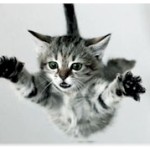Its physics really. Studies have shown that cats can fall from remarkable heights with incredible survival rates. It’s proven that cats can fall from as high as 32 stories and live to purr about it. Here’s why:
The Cat Righting Reflex
The reason cats are able to land relatively safely after a fall is due to their “righting reflex”. This is a cat’s innate ability to orient itself into an upright position (in midair) and land on its feet after a fall. This reflex begins to appear at 3-4 weeks of age, and is perfected at 7 weeks. This is possible for cats because they have a very flexible backbone and non functional clavicle (collarbone). Cats’ inner ears also act as an internal gyroscope.
Studies
 According to studies done by the Journal of the American Veterinary Medical Association (JAVMA), a cat’s terminal velocity is low, around 60 mph. This allows for a “softer” landing. In the JAVMA study, it was shown that 132 cats falling from an average of 5.5 stories and as high as 32 stories had a survival rate of about 90%. Of those 132 cats, only 2/3 required some sort of medical treatment as a result of their fall.
According to studies done by the Journal of the American Veterinary Medical Association (JAVMA), a cat’s terminal velocity is low, around 60 mph. This allows for a “softer” landing. In the JAVMA study, it was shown that 132 cats falling from an average of 5.5 stories and as high as 32 stories had a survival rate of about 90%. Of those 132 cats, only 2/3 required some sort of medical treatment as a result of their fall.
It should be recognized however, that this doesn’t imply that ALL cats falling from any height will have a 90% survival rate. Believe it or not, the lower the height a cat is falling from, the better chance there is of injury. The lower the height, the less time he or she has to correct their positioning and land on their feet. The higher a cat falls from, the more time is given to get the correct posturing. A cat’s chances of injury decrease above the height of 7 stories due to their changing velocities.
How do cats create a lower terminal velocity?
In a study performed on cats and their changing velocities, it was shown that cats, at the beginning of their fall, tense up. They arch their backs as they do when they are frightened. This creates a much higher velocity because they are reducing their surface area, causing them to fall faster. After falling for 7 stories however, a cat begins to spread out, relax, and create more surface area causing their fall to slow down considerably. They form a stance like that of a flying squirrel. With a larger surface area, cats increase their air resistance and reduce their terminal velocity. This creates a “softer” landing, reducing the chance of injury.
If you would like to schedule an appointment for your cat click here : http://northernilcatcliniccom.web.siteprotect.net/schedule-appointment/